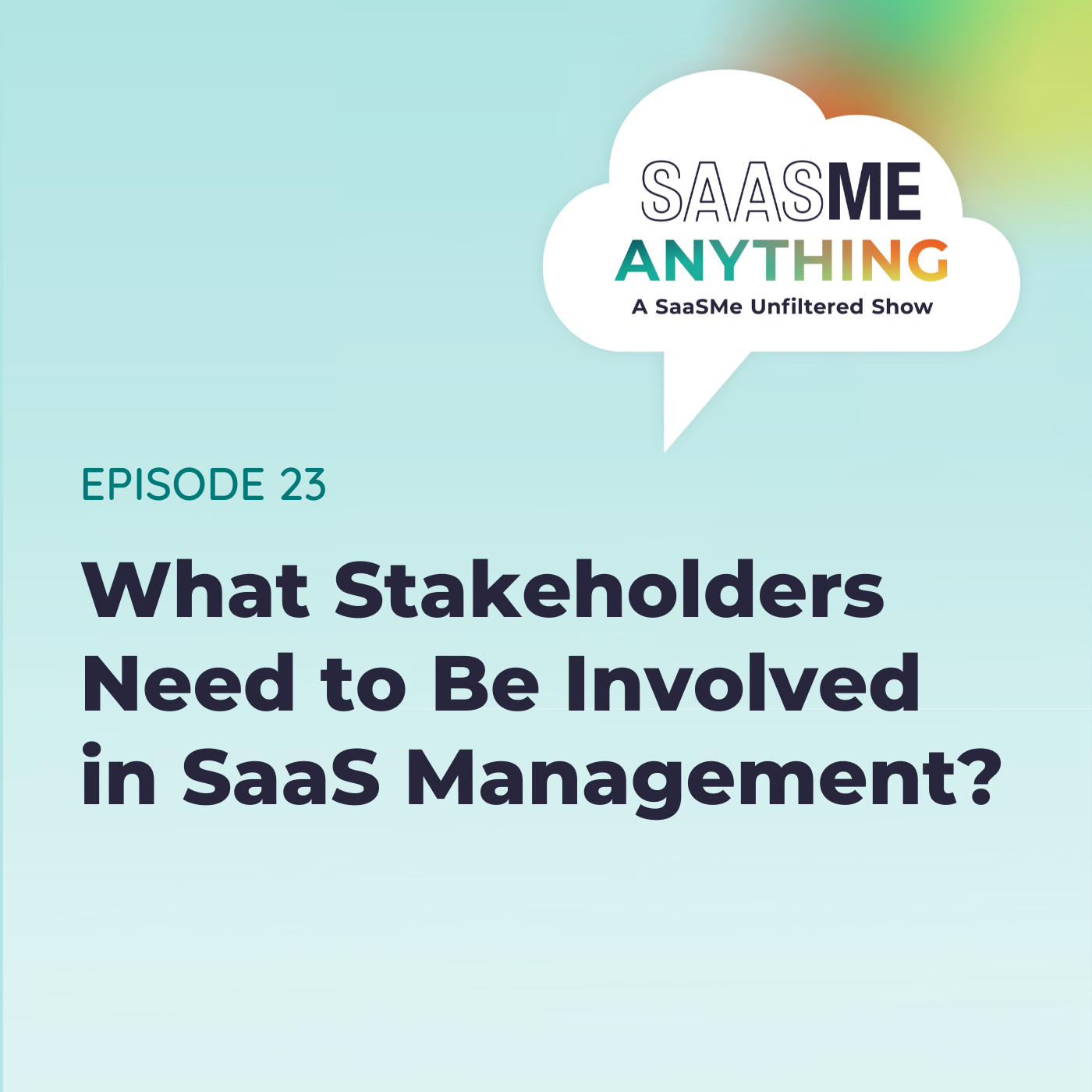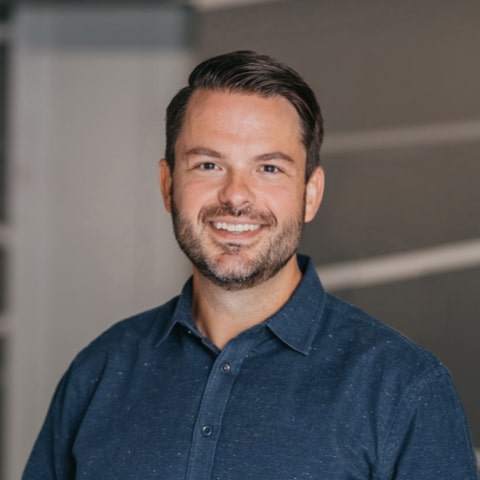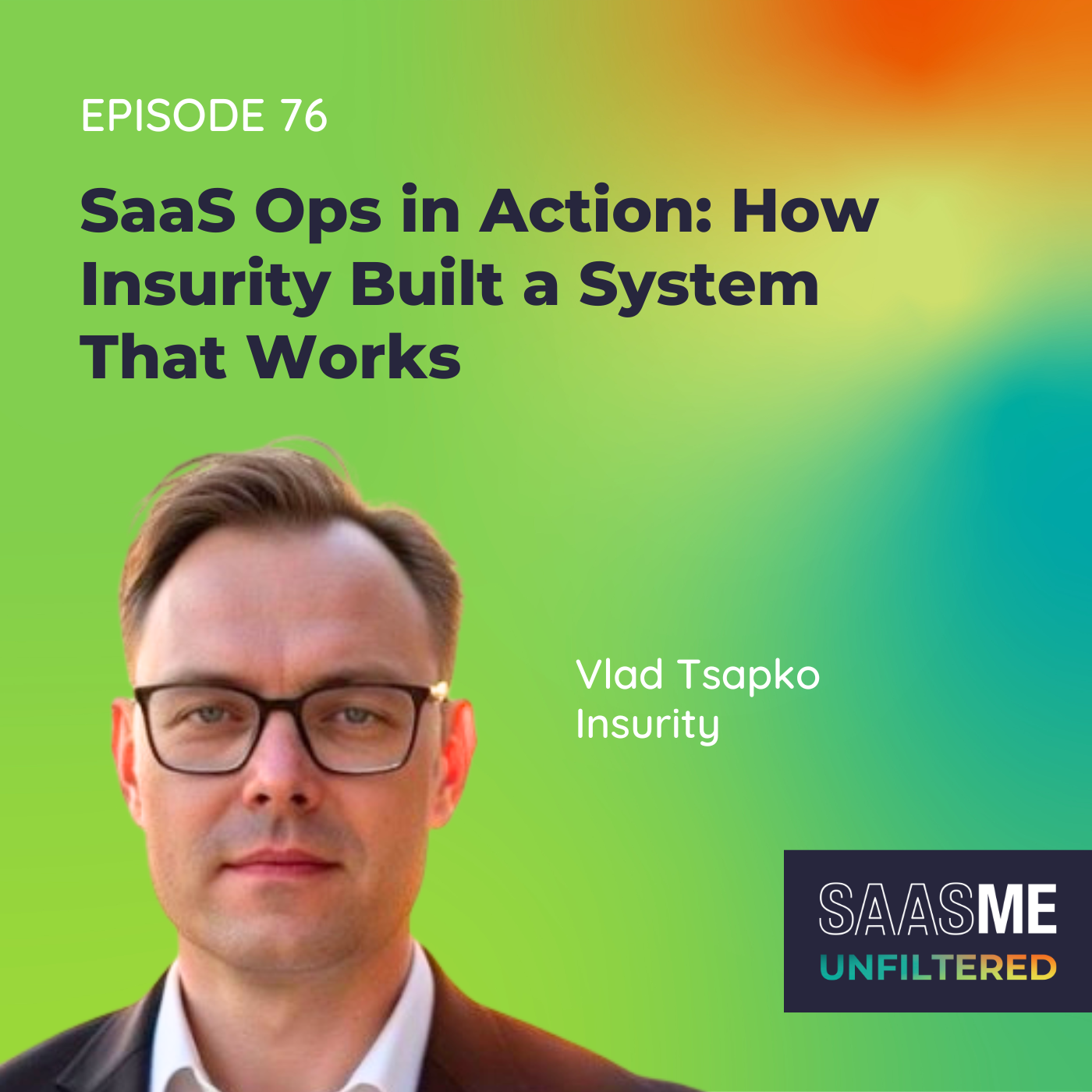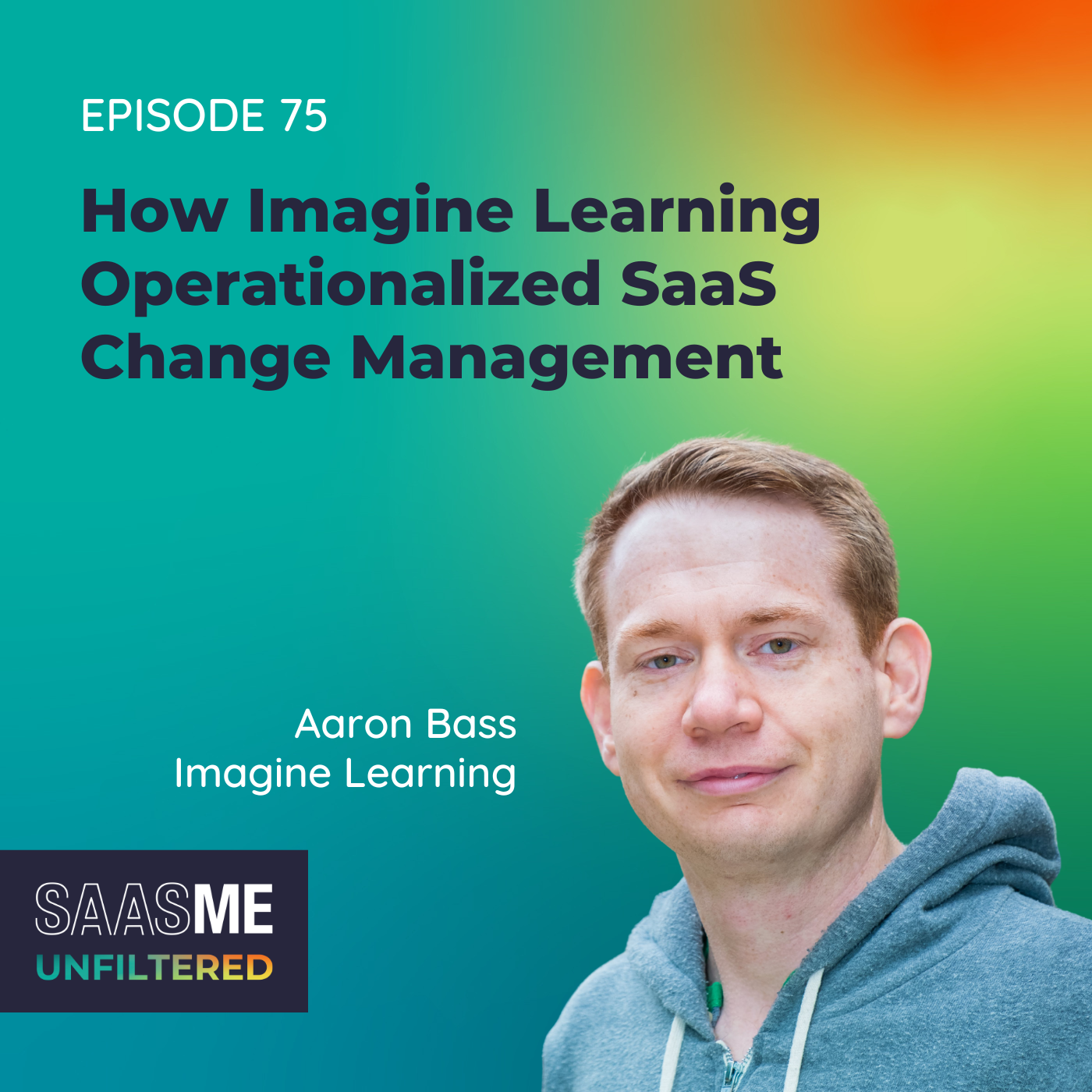What Stakeholders Need to Be Involved in SaaS Management?
- 0.5
- 1
- 1.25
- 1.5
- 1.75
- 2
Ben Pippenger: Do you ever wonder, why is SaaS so hard to manage? What can I do about it? How can I save money on SaaS? Is product bundling a thing? You likely have a ton of questions about SaaS management, but frankly, there aren't a lot of answers out there. I'm Ben Pippenger, your resident SaaS expert, and this is SaaS Me Anything, the show that brings clarity to the chaos of SaaS. All right. Hey everyone, and welcome to SaaS Me Anything.
Ben Pippenger: Now that we are all on the same page about what SaaS Management is from our last episode, let's talk about who within your organization needs to be involved when you're thinking about a SaaS management program. I was thinking about how I can relate this back to maybe something we've all experienced in our own lives, and I tied it back to a restaurant. And when you think about when you're sitting there at a restaurant and you order your food, how did that food get to your table? You've got to think about all the different moving parts and pieces. Everything from potentially all the way back to the farm that the food came from, or the manufacturer the food came from, the trucks the food arrived on, the ingredients arrived on at the restaurant. You could have the best chef in the world working at this restaurant cooking the food for you, but if the service is subpar and you get your food cold, or maybe you order a beverage and the bar tender isn't there to make your drink and it was something you really wanted, it could result in a really bad experience for you and maybe even potentially ruin the meal for you.
Ben Pippenger: And so when you think about SaaS management, the same goes for SaaS management too within organizations. It really requires cross- departmental collaboration for it to be successful. At Zylo, we often say SaaS management's a team sport, because it truly is. So leading into today's episode, we're going to be talking about and looking at those key stakeholders that are critical to SaaS management within the enterprise.
Ben Pippenger: So this all comes back to the problem that SaaS is decentralized. So it's decentralized from the standpoint of there's not one group within an organization that's responsible for SaaS, that's buying SaaS. It's a very crowded market. There's lots of providers out there to really get your arms around even what's going on, and the bottom line is that nobody owns SaaS within organizations.
Ben Pippenger: So how do you put a system and a program in place to then manage the thing that nobody owns? Well, usually, it comes back to two key executives within an organization, the CIO and the CFO. And why are those two people typically the ones that are involved? Well, those two are the roles that are usually accountable for ensuring the organization is executing on your strategic business objectives, and again, that's aligned back to then the software that's being used and being purchased and the money that's being spent on those tools.
Ben Pippenger: So if you look at those organizations and you think about, well, what do they care about when it relates back to software and to SaaS? Well, let's start with the world of the CFO and finance. So within finance and the CFO's world, the things that they really care the most about is going to be the dollars. Are we planning appropriately? Are we forecasting appropriately? Are we spending the right amount on software? And if they can get the right visibility and have trust in that information, they feel like they have their arms around what's going on around what is a very decentralized category, as we said earlier. And then also, typically within the office of the CFO but also can exist inside of IT is procurement. And you think about the procurement teams that are out there, they're really striving to make sure that employees and the business are getting the most value out of the applications that are being chosen to be used within the company. So they're looking to make sure that they're being strategic with the vendors that you're working with, they're ensuring that you're paying the right price for the applications that you're using, and really helping to drive a lot of the process around the purchasing and the renewal lifecycle stages of an application.
Ben Pippenger: Now, if we flip over to the world of the CIO and inside of IT teams, they're really thinking about what is our employee's experience? Are they getting the right tools? Do they have access to the right tools? Can they get them quickly? Are we staying within any controls or boundaries that we have from a compliance and risk perspective in order to protect the business? And then within those teams, you're going to find folks like software asset managers, we talked about SAM Teams on the last episode as well. And those groups are really going to be looking at and focused on a lot around licensing and making sure that the license position is correct for a lot of the different software titles that you're using, both on- premise as well as SaaS applications.
Ben Pippenger: And then the last stakeholder here are the app owners themselves, so the folks within the business that are the ones that are responsible for buying these tools, that are responsible for selecting the tools that are going to be used within the organization. So really thinking about them from the standpoint of do they have all the information they need to understand how that application is being used, what the renewal process looks like, and are you, again, getting the most value for the tools that they've chosen to use for the business?
Ben Pippenger: So each role as we think about this is very important and you really need to think about each one. As we said earlier, SaaS is not owned, it's decentralized, but the interesting thing about it as well is it's really touched by everyone within a company, so you need to make sure you're taking all their needs into account. So how do you do that? How do you bring all of these different stakeholders together in order to align around what you're trying to accomplish with the SaaS management program?
Ben Pippenger: Well, first things first, you of course have to bring them to the table and you need to align on the key business objectives that you want to achieve by putting a SaaS management program in place. So a couple of examples of those objectives that we often see is, number one, our business needs to operate more efficiently. We need to have a better model, we need to be doing more with less, and just operate a more efficient business. Next, we often see organizations wanting to remove risk from any sort of exposure they have with the applications that they're using and any the unknowns that may be out there. And then lastly, and this is probably the biggest one that we see a lot of people surfacing up as they're bringing and prioritizing SaaS management as an initiative, is they need to save money. Lots of dollars are going to SaaS applications and it's growing year over year, and organizations are really wanting to get their arms around that to avoid spending and saving money. All right, so that's first things first. So aligning around those key business objectives.
Ben Pippenger: And then ongoing, so as you get alignment there to know what it is you're trying to accomplish, what are the key things you need to make sure that you're doing on an ongoing basis? Number one, everyone needs to have visibility to all these different applications that are out there in order to get the full picture of what's happening. So from a CIO's perspective, they're really wanting to understand what's coming into the environment, what sort of risks are being introduced, what sort of unknowns are out there for things they didn't even know about. On the finance end, they really want to understand what the spend looks like. They're going to want reporting or on what that spend looks like on an annual basis in order to understand if budgets and forecasting is accurate for the organization. And then when you think about app owners and what app owners really are going to be caring about, it's what users have access to the applications that I'm responsible for, what applications are renewing soon, and then all the way down the line to what applications are even available to me as an end user in order to get access to at the company I work at.
Ben Pippenger: Next key area of ongoing need is around aligning on those outcomes. We talked about cost savings earlier as being a big example of an outcome that businesses are trying to achieve by putting SaaS management in place. You have to make sure that when you align those outcomes, you're then putting a system in place and then track if you are getting towards those outcomes and how you're performing against what your original expectations were in order to measure those things accordingly.
Ben Pippenger: And then third on the ongoing basis is to operationalize the renewable process and operationalize SaaS management. So really, putting a system in the ongoing operational rhythm in place to consider what applications are entering into your environment, looking at any of those risks that are being introduced to your organization by those applications, operationalizing the renewal process so that as renewals are coming up, you're knowing what renewals are coming, you're taking a data- driven approach, a proactive versus a reactive approach to managing those renewals, and then also on top of that, staying on top of any initiatives that you may be pushing through to optimize your licensing for the different SaaS applications that your organization is using, to make sure that you're removing waste and optimizing the licenses that you've purchased.
Ben Pippenger: So the bottom line here is to be successful at SaaS management, number one, make sure you have all of the right people at the table. You need a cross- functional team of IT, finance, as well as the line of business leaders that are responsible for buying these applications. The second thing is to ensure you have the visibility you need in order to drive the right outcomes and you have alignment around those outcomes across those key stakeholders. And then the last thing is you need to operationalize the program across your business to make sure that you understand what's going on, that you're measuring your results, and hopefully, finding a lot of success.
Ben Pippenger: Do you have questions about SaaS and how to manage it? Submit your questions at the link in the show notes and tune in next time for more answers from your trusted source of SaaS management insights and trends. Go ahead, SaaSMe Anything.
DESCRIPTION
SaaS is decentralized within every organization, making it difficult to understand who owns it. But want to know a little secret? Everyone owns it. That’s why it takes a cross-collaborative effort between IT, Finance, and line of business leaders to drive successful SaaS management – what we like to call a team sport. In this episode, we discuss all the key players and how they rally together to achieve their aligned business outcomes.
Have a question you’d like answered on SaaSMe Anything? Submit yours here.
Key Takeaways:
- [00:36 - 02:10] SaaS management requires cross-departmental collaboration
- [02:11 - 02:32] SaaS is decentralized
- [02:33 - 03:10] How do you create a system for something nobody owns?
- [05:30 - 06:45] Everyone at an organization uses SaaS, so bring them to the table
- [07:56 - 09:05] Aligning key business objectives
- [09:06 - 09:43] The bottom line for success in SaaS management
SaaSMe Anything is the bi-weekly podcast that brings clarity to the chaos of SaaS, hosted by your resident SaaS expert and Zylo co-founder Ben Pippenger. Connect with Ben on LinkedIn here.










